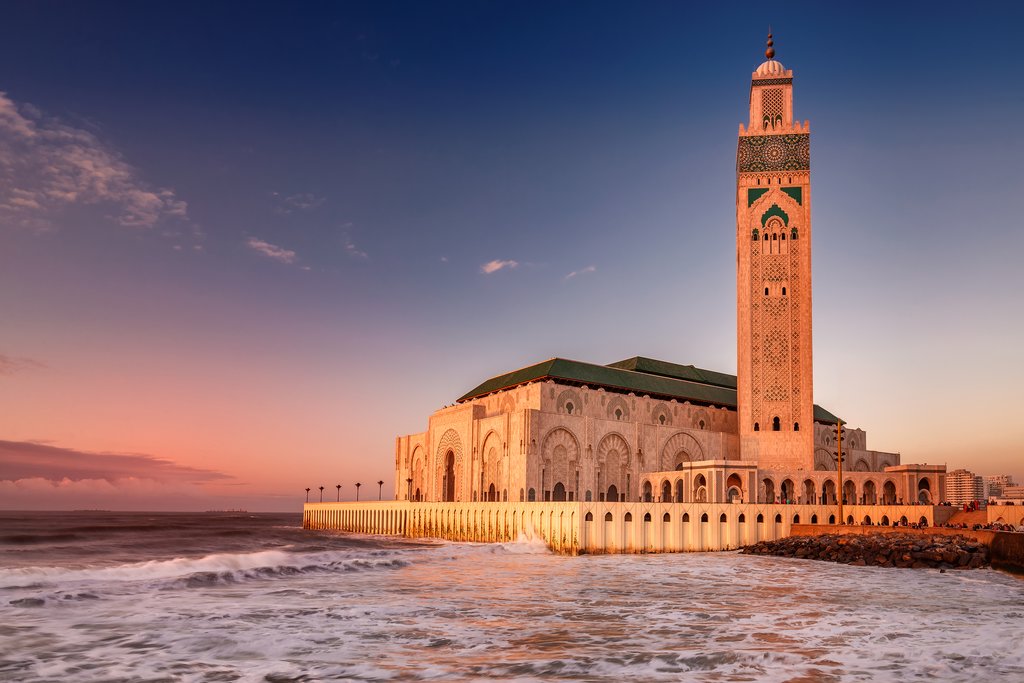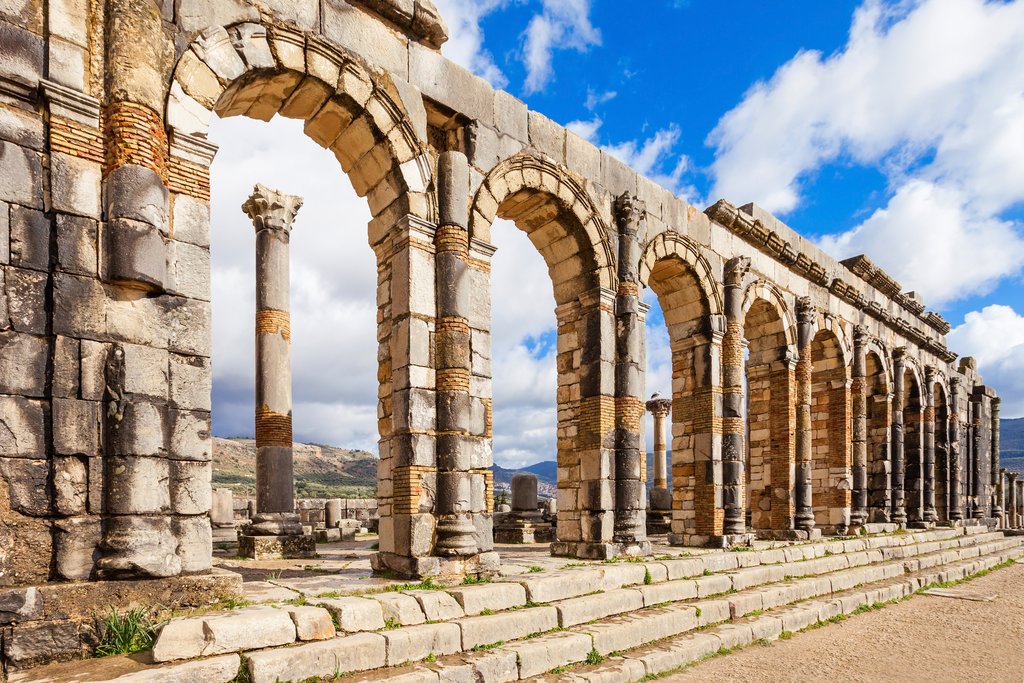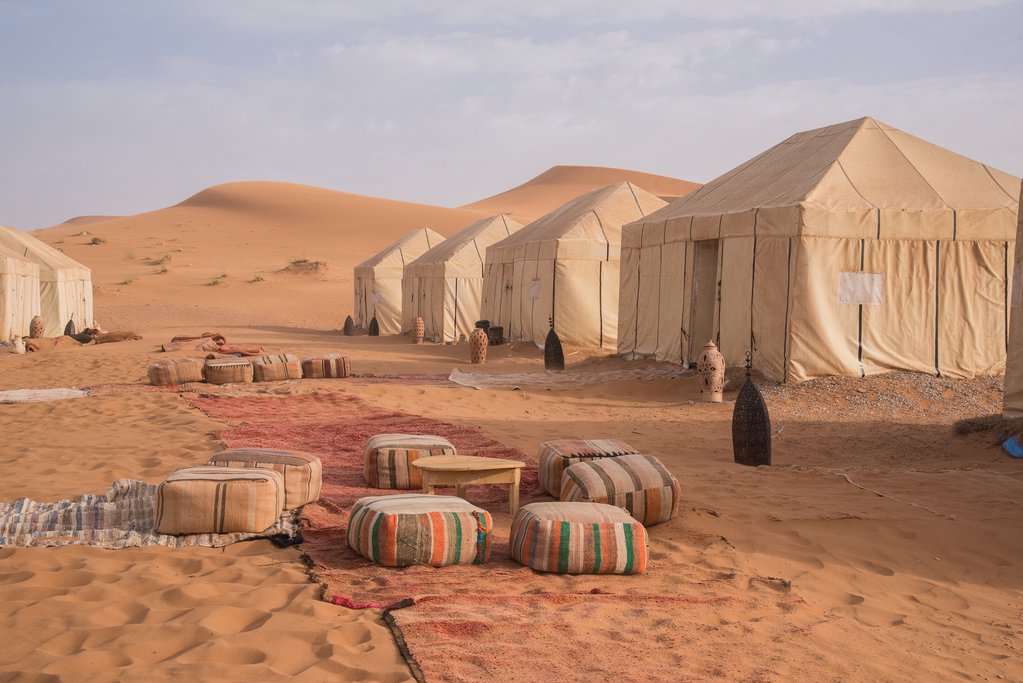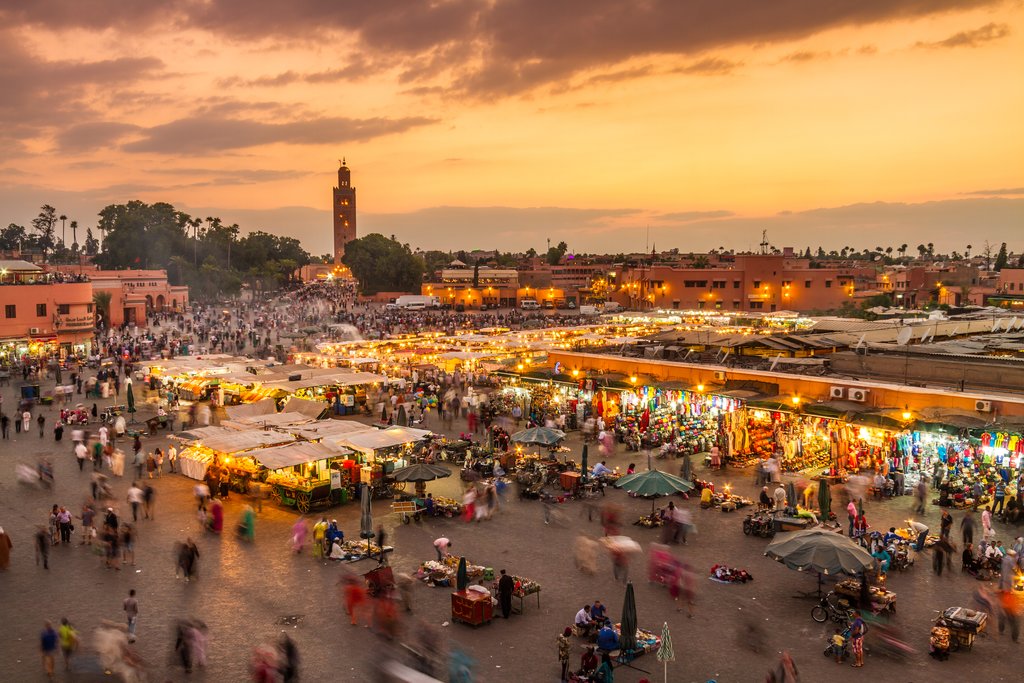Highlights
- Explore sand dunes, oases, hidden valleys, and old kasbahs in the desert
- Wander ancient medinas and souks in Marrakesh and Fes
- Enjoy the sunset over the Sahara and the "Blue City" of Chefchaouen
- Visit local artisan workshops and collectives for leather, ceramics, and argan oil
Brief Itinerary
| Day | Highlights | Overnight |
|---|---|---|
| Day 1 | Arrive in Casablanca, Explore | Casablanca |
| Day 2 | Explore Chefchaouen, Transfer to Fes via Volubilis & Meknes | Chefchaouen |
| Day 3 | Transfer to Fes via Volubilis & Meknes | Fes |
| Day 4 | Explore Fes | Fes |
| Day 5 | Transfer to the Sahara Desert via Midelt, Erfoud & Merzouga | Merzouga |
| Day 6 | Sahara Desert Fun, Transfer to Ouarzazate via Todra Gorge & Dadès Valley | Ouarzazate |
| Day 7 | Transfer to Marrakesh via Aït Benhaddou & the High Atlas | Marrakesh |
| Day 8 | Explore Marrakesh | Marrakesh |
| Day 9 | Transfer to Casablanca, Depart |
Detailed overview
Day 1: Arrive in Casablanca, Explore

Welcome to Casablanca, the Art Deco capital of Africa. On arrival at the airport, a private driver will meet you for a transfer to your hotel. If you only visit one place in Morocco's modern commercial capital, make it the Hassan II Mosque. The largest mosque in Morocco and the only one open to non-Muslim tourists, you can explore the superb architectural masterpiece and learn about its history with a short guided visit.
Marvel at the 656-foot (200 m) high minaret, the tallest in the world, and admire the ornate design with beautiful green hues and mosaic tiles, lavish wood, marble, carved stone interiors, and arched ornamented ceilings. This monumental structure can hold 25,000 worshippers inside and 80,000 more in the courtyard. Later, you could stroll along the beachfront Boulevard de la Corniche, take a coffee at Rick's Café (from the famous film), or shop through Hobous, Casablanca's "New Medina" that is home to Art Deco architecture.
Day 2: Transfer to Chefchaouen via Rabat

This morning, take a one-hour private transfer to Rabat, an imperial city and the capital of Morocco since 1956. Enjoy a quick stop at the bustling UNESCO World Heritage city. You could visit the Royal Palace of Rabat and the medieval fortification of the Chellah Necropolis, stroll through the medina to find the Hassan Tower and Mausoleum of Mohamed V, or find tranquility at the Andalusian Gardens, a 20th-century oasis with lush terraces filled with exotic plants, flowers, and fruit trees. Return to your driver for a four-hour journey to Chefchaouen.
Chefchaouen, also known as the "Blue City," is waiting for you to explore its colorful streets, sites, and monuments. The town, which translates to "two horns," is nestled among the majestic and raw peaks of the Rif Mountains and was founded in the 15th century as a stronghold against the Portuguese. Chefchaouen is one of the prettiest towns in Morocco, an artsy, blue-washed mountain village that feels like its own world. End your day on the hill at the Spanish Mosque, where you enjoy views over Chefchaouen as the sun sinks into the mountains.
Day 3: Explore Chefchaouen, Transfer to Fes via Volubilis & Meknes

Rise early to explore Chefchaouen's old medina, a delight of Moroccan and Andalusian influence, without the crowds. Many travelers leave in the morning, and others don't arrive until the afternoon, so use this time to snap your unobstructed photos with the bright-blue buildings and around Plaza Uta el-Hammam and its restored kasbah. On the journey to Fes today, you'll take a short detour to the Roman ruins at Volubilis, a 2,000-year-old UNESCO World Heritage Site, to see impressive merchant homes, temples, and vibrant mosaics and learn about its history.
After, continue to Moulay Idriss, one of Morocco's holiest cities and where Islam was introduced in the region in 789 CE. Then, head to Meknes, an imperial city founded in the 11th century. Under the reign of Moulay Ismail (1672–1727), Meknes grew from a small town to a magnificent capital. Admire the monumental city gates and decorative Spanish-Moorish architecture. Tour the city walls and stop at the Mausoleum of Moulay Ismail. End at the Museum of Moroccan Art to view various regional handicrafts before you continue to Fes, the third imperial city, on this trip.
Chat with a local specialist who can help organize your trip.
Day 4: Explore Fes

Fes is the oldest of the four imperial cities in Morocco and perhaps the most interesting to explore. This fascinating city is home to the most complete medina in the Arab world. The UNESCO-listed Fes el-Bali is a labyrinth of more than 9,000 narrow winding streets, intricate mosaics, and ornate doorways that will take you back in time. The best way to navigate the world's largest living medieval medina is with a private guide. Discover hidden stories and secluded corners, and observe both the minutia of daily life and the magnificence of the madrasas and palaces.
Fes is a hub of Moroccan crafts and arts, and you'll meet artisans to learn about the history of their trades. Visit tanneries and mosaic workshops to observe traditional crafts still in use today. If you have an interest, you can visit the Musée Batha, and in the souks, you can shop for spices, vegetables, leather goods, ceramics, metal, shoes, scarves, medicines, and more.
Day 5: Transfer to Sahara Desert via Midelt, Erfoud & Merzouga

Get an early start today for a long day over the Middle Atlas to reach the sand dunes of the Sahara Desert near Merzouga. After the town of Azrou, climb up and over the Col du Zad pass (7,146 ft/ 2,178 m) and through the cedar forests of the Middle Atlas mountains. Say hello to families of Barbary macaque monkeys before continuing to Midelt for lunch. Continue over the Tizi-n-Talremt pass and into the Ziz Valley, known for its hidden oases and clusters of palm trees. Admire fortified houses known as ksars, built by merchants to protect gold, salt, and spices.
Just before reaching Erfoud, you'll start to see the ever-shifting Saharan dunes. Near Merzouga, take a short break to enjoy a camel ride through the dunes before you reach your luxury desert camp just before sunset. Settle into your Bedouin-style tent, then climb up the nearest dune to watch the sunset display its color show across the sands. Return to camp for dinner and a night by the campfire enjoying traditional Berber music from the locals. Before you head to bed, take a look at the sparkling night sky.
Day 6: Sahara Desert Fun, Transfer to Ouarzazate via Todra Gorge & Dadès Valley

Wake up early to witness a spectacular sunrise over the sand dunes before the fun begins. Choose to explore Erg Chebbi, a surreal sea of sand stretching over 17 miles (28 km), in a Jeep, or rent a sandboard or ATV bike. Before lunch, you'll hit the road again for the five-hour drive to Ouarzazate. Your private driver will pause in Rissani, the birthplace of the current Alawi dynasty, where you can see the tomb of its founder, Moulay Ali Cherif. Continue to Tinghir, a desert town with fantastic views of an extensive river oasis with 30 miles (48 km) of palm trees.
Then, discover the 984-foot-high (300 m) Todra Gorge and walk through the red-stained limestones, or relax in the cool, shallow water. Passing Boumalne Dades, you'll cross the Dades River toward El Kelâat M'Gouna, the "Valley of the Roses." Admire cultivated rose bushes and discover how the petals become rose water and oil for the cosmetic industry before continuing west to Ouarzazate—Morocco's Hollywood—where you can tour a movie studio or visit the Musée du Cinema. After a big day of travel, relax at your hotel, ready for another day on the road tomorrow.
Day 7: Transfer to Marrakesh via Aït Benhaddou & High Atlas Mountains

Aït Benhaddou is the most famous Kasbah in Morocco and a UNESCO world heritage site. This morning, you'll stop at the ancient town to admire the earthen buildings on the 3.5-hour transfer to Marrakesh. Defensive walls, angled towers, and an armored gate surround Aït Benhaddou's earth homes. Learn about pre-Saharan earthen construction techniques and see the famous film location up close. If you'd like, you can pay a small fee to enter a few of the kasbahs (fortresses) and climb up to the rooftop for pretty views of the surrounding ksours (individual kasbahs) and the Ouarzazate Valley, an oasis in the red desert.
As you continue up and over the High Atlas, look out for the highest peak, Mount Toubkal, at 13,671 feet (4,167m). Near the top of the Tizi n'Tichka Pass (7,415 ft/ 2,260 m), you can enjoy great panoramic views over the mountain range, as well as the road ahead that snakes down the mountainside. You can pause in Taddert at an argan oil cooperative to learn how the nuts are processed. After all the tranquillity of the mountains and the desert, you'll soon be in the midst of the hustle, bustle, and clamor of vibrant Marrakesh.
Day 8: Explore Marrakesh

Marrakesh has always been a bustling city filled with foreign sights, sounds, and smells. For some, it can be a bit of a shock to the senses. The "Red City," named for the natural red ochre pigment in the walls, is the fourth and final imperial city on your trip. It was founded by Youssef Ben Tachfine around 1070 under the Almoravid dynasty. Unlike Fes, Marrakesh has Berber rather than Arab roots and history, once being an important trading capital for tribes of the Atlas mountains, as well as along trading routes through Ouarzazarte and the sub-Sahara.
You may like to join a private guide for a half-day exploration of historical sites such as the Koutoubia Mosque, the Saadien Tombs, the 19th-century Bahia Palace, El Badi Palace, the 16th-century Medersa Ben Youssef, and the Jewish Quarter. Wind your way through the colorful and lively UNESCO World Heritage-listed medina, visiting different artisan areas within the souks where you can barter for souvenirs or gifts. As evening falls, venture into the central square of Jemaa el-Fna for an energetic final evening in Morocco with street food, storytellers, and snake charmers.
Day 9: Return to Casablanca, Depart

Your nine days in Morocco come to an end today. This morning a private driver will transfer you from your hotel in Marrakesh to the airport in Casablanca, a 3.5-hour journey. You'll arrive in time for your flight home or onwards. Safe travels!
More Great Morocco Itineraries
Looking for more inspiration for your trip to Morocco? Check out these other Morocco itineraries, explore different ways to spend nine days in Morocco, or discover the best time to visit Morocco.


